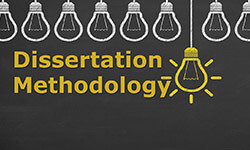Writing Your Dissertation Methodology
The methodology chapter is a fundamental component of your dissertation and should be written in the past tense. Writing your dissertation methodology thoroughly explains the approaches employed while also highlighting the reasoning behind their selection and application in the study. This section follows the literature review and appears after clearly outlining the research questions to the audience. However, dissertations vary with institutions in that not all of them need the methodology section included in their work. Therefore, if you are pursuing a PhD or master’s program, at some point you will have to submit a dissertation that involves research from a particular project.
 The methodology should establish a solid relationship between the research questions and the existing knowledge of scholars in your literature review section. Therefore, your dissertation methodology is set to develop as you plot your literature review. Conversely, the methodology section is primarily meant to explain the reasons you chose to use those techniques to collect your data and observations during your research. Your audience should be able to obtain adequate information about the methods you and may use the same methods to obtain their data.
The methodology should establish a solid relationship between the research questions and the existing knowledge of scholars in your literature review section. Therefore, your dissertation methodology is set to develop as you plot your literature review. Conversely, the methodology section is primarily meant to explain the reasons you chose to use those techniques to collect your data and observations during your research. Your audience should be able to obtain adequate information about the methods you and may use the same methods to obtain their data.
The two types of research include primary and secondary research.
Primary research. This type of research involves consulting the source directly to ask questions and gather necessary information. When conducting primary research, usually one expects to gather both the exploratory and the specific basic types of information. The research is either general and open-ended or precise with formal interviews. Primary research is often complex than secondary research but it provides results that are more reliable. Examples of primary research include surveys, interviews, questionnaires, files captured and focus groups.
Secondary research. Secondary research is the type that reviews information that has been collected, compiled, organized and published by other scholars to improve the validity of the research. Most of the secondary research is found on the web, through reading articles, documentaries and critical reviews. Contrary to primary research, this type can be obtained easily and less costly than primary research.
Qualitative Dissertation Methodology
Qualitative research is the method of using particular case studies and small samples with the aims of obtaining details of the main issue. The keyword is “qualitative”; therefore, this type of research is associated with the collection of evidence to obtain suitable answers to questions. Qualitative research involves the observation of human behavior, the use of questionnaires, consulting focus groups, and interviews. Observation is executed by watching that particular group you are studying. One can be a participant observer or rather act as a non-participant observer.
In the former, the researcher acts as an active member of the group he/she is observing while in the latter, they are not within the group but still observing. However, being a participant elevates the chances of obtaining vital information compared to playing the non-participant role. Questionnaires limit the data you need by answering only what you ask. Sampling of focus groups makes it easier by providing a sample to represent the entire large population. On the other hand, interviews offer the opportunity to ask whatever questions you want and analyze the answers rather than just reading them.
Quantitative Dissertation Methodology
Quantitative research employs empirical formats, mathematical models and theories to interpret the collected data. The types of data used include numerical, non-numerical, continuous and discrete data. There are also varieties of quantitative research methods that are useful in obtaining the desired data. Surveys gather data and can target any particular data that you intend to study.
Additionally, it is quite easy to set up and analyze the obtained data when using survey method. Its limitation, however, is that it can be biased to answers and questions posed during the study. Mathematical modelling is very significant for providing a general pattern that can act as a reference point using mathematical language. Alternatively, renowned laboratory experiments is a unique type of the quantitative research method but does not favor all the researchers, especially social scientists.
Mixed-Methods Dissertation Chapter
This type of research methodology is an approach that combines both quantitative and qualitative forms. It involves collecting and analyzing both qualitative and quantitative data within the same study. This research method is suitable for answering research questions that neither qualitative nor quantitative methods could answer independently. Mixed methods research comprise of exploratory, explanatory, nested and parallel types of design categories.
Factors to Consider When Writing Your Dissertation Methodology
A typical methodology structure should be plotted with the help of the following considerations:
The research design. This is the framework of research techniques that you choose for your study. There are types of research designs including data collection, measurement, and data analysis. Therefore, in your study, you have to explain the reasons why you preferred those data collection and analysis methods in your research. A research design is often significant because it creates less bias and tends to improve accuracy in data collection.
However, the primary aim of any research design is to assist you in answering the research questions. Some of the vital elements of a research design may comprise the techniques employed for data collection and analysis, methods applied for analysis of collected data, the type of research methodology, and measurement of analysis. Nevertheless, neutrality, reliability, and validity should also be featured as part of your research design.
Philosophical approach. In your methodology, you have to consider specifying the kind of research philosophy you will apply during your study. It can either be positivism, pragmatism, interpretivism, and realism. The essence of a research philosophy is that it deals with ways in which data regarding a particular phenomenon should be gathered and analyzed. This means that it can either be a qualitative, quantitative, or mixed research methodology. However, addressing a research philosophy involves the formulation of some assumptions and beliefs. These assumptions will later play a major role and act as a foundation for your research strategy.
Methods of data collection and analysis. This portion requires you to specify the various ways that you used to gather information and the tools involved in the process. You must also state it clearly if you used a particular software and explain why you preferred using it. Note that there should exist a consistent relationship between your results and the research questions to avoid misleading your audience. Generally, ensure that your results are valid and reliable in nature.
Ethical considerations. It is however essential to consider how your study will affect people outside your research. A good research ought to be individual friendly and should not pose any danger throughout the entire process.
Authenticity. It is only when you employ a perfect research design when you expect valid and reliable results. The supervisor expects to obtain similar results each time they conduct they conduct the same research study.
Limitations. Approximately all research studies experience limitations. Acknowledging and accepting such demerits enables perfection during the next study.
The Process of Writing Your Dissertation Methodology Chapter
- A review of your research questions. Fundamentally, your specified research methodology justifies that it can answer all the research questions that you posed at the beginning of the study. However, you must review the main questions that you want to answer when introducing the research methodology. This can be achieved by restating the chief problem in a manner that correlates with both the methodology and the literature review.
- An account of your research design. Research design happens to be the core of your research methodology. In this section, you are expected to explain the entire data collection and analysis process to solve your research questions. The whole research design should be exhaustive and clear such that the reader can apply it somewhere else. In the case of sciences, your audience should be able to reinvent the same experiment in a laboratory.
- The background and rationale for your research design preference. The research methodology not only explains the methods you employed but also elaborates further on the reasons you preferred such methods and why you trust that it certainly would yield perfect results. You should liaise with information from other scholars from the literature review section and at the same time portray sound creativity. Nonetheless, it is however significant to vividly relate the rationale for your preferred methods to the main research problem. This generally shows that your chosen research methodology would be most suitable for answering the posed research questions.
- An evaluation of your research methods and limitations. You do not expect a smooth experience throughout the entire research process without running into a few obstacles. Therefore, regardless of the type of research method you have selected to work with, you should be ready to acknowledge the challenges that come along with it. Be prudent and open about the limitations of your preferred method that will come your way and you should be in a position to validate why that particular approach perfectly suits your aims.
Contact us if you need any dissertation assistance or chapter 4 of your dissertation. We can help you conduct analysis using SPSS, STATA, Excel, NVivo, Tableau, AMOS, and other software.
Get a 15% Discount on Your First Order!

